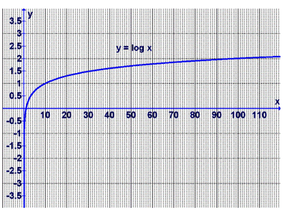Logarithmic Time Perception
Have you ever wondered why it seems as though the older we get, the quicker we perceive the years to go by?
We usually think about the years of our lives in terms of decades: our teens, twenties, thirties, etc. This is an implicitly linear view: that all our years are equal. While yes, every year is the same amount of time, humans perceive this time differently as we age. For example, when a 10-year-old is going through fifth grade, they may complain about how long it feels, how slow time seems to be passing. Yet, an 80-year-old feels as though her 79th year passed by very quickly.
Since the linear view of time perception seems inadequate, it is reasonable to look for a non-linear alternative. The observations we make about the perceived shrinkage of our years as we age strongly suggest a logarithmic scale: stretched out at the low end and compressed at the high end.
We usually think about the years of our lives in terms of decades: our teens, twenties, thirties, etc. This is an implicitly linear view: that all our years are equal. While yes, every year is the same amount of time, humans perceive this time differently as we age. For example, when a 10-year-old is going through fifth grade, they may complain about how long it feels, how slow time seems to be passing. Yet, an 80-year-old feels as though her 79th year passed by very quickly.
Since the linear view of time perception seems inadequate, it is reasonable to look for a non-linear alternative. The observations we make about the perceived shrinkage of our years as we age strongly suggest a logarithmic scale: stretched out at the low end and compressed at the high end.
Consider this graph of y=logx to have an x-axis representing age. From ages 5-6, time seems to be going quite slow because there is a relatively large change from log(5) to log(6)...log(6)-log(5)=.079
Since there is a relatively large change from log(5) to log(6), this is as if humans are perceiving a "lot of time" in just this one year interval from 5-6. Hence, time seems to move slow. However, consider from ages 50-51. Time seems to move very quickly from 50-51 because there is such a slight change from log(50) to log(51)....log(51)-log(50)=.0086. Since there is only a slight change from log(50) to log (51), this is as if humans are perceiving "a little time" in this one year interval from 50-51. Hence, time seems to move quickly. Notice that the log(6)-log(5)=.079 and log(51)-log(50)=.0086 and .079/.0086=14.139 so if humans do really perceive time logarithmically, one could say that ages 5-6 move about 14.139 times slower than ages 50-51. Cool, right?
Since there is a relatively large change from log(5) to log(6), this is as if humans are perceiving a "lot of time" in just this one year interval from 5-6. Hence, time seems to move slow. However, consider from ages 50-51. Time seems to move very quickly from 50-51 because there is such a slight change from log(50) to log(51)....log(51)-log(50)=.0086. Since there is only a slight change from log(50) to log (51), this is as if humans are perceiving "a little time" in this one year interval from 50-51. Hence, time seems to move quickly. Notice that the log(6)-log(5)=.079 and log(51)-log(50)=.0086 and .079/.0086=14.139 so if humans do really perceive time logarithmically, one could say that ages 5-6 move about 14.139 times slower than ages 50-51. Cool, right?

